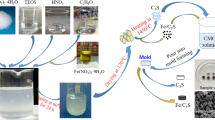Abstract
A novel bone glue composed of tricalcium silicate and high proportion of type I collagen is proposed. Tricalcium silicate (C3S) is one of the most promising biomedical materials on bone cement due to its excellent biocompatibility and self-curing properties. By adding the type I collagen and carboxymethyl cellulose (CMC) to increase the adhesion and biocompatibility to the human tissue, the proposed composite bone glue shows excellent adhesive strength to 416 kPa, tensile strength to 167 kPa, and increasing mechanical strength after curing in simulated body fluid. Furthermore, results of diclofenac sodium drug releasing test show that after 2 days, the release increased from 46 to 53% and then maintained about 53%. Among all different collagen to C3S ratio, 40 wt% collagen and 60 wt% C3S composite bone glue has great potential to be a novel bone glue carrying with drugs.














Similar content being viewed by others
References
Chivers, R.A., Wolowacz, R.G.: The strength of adhesive-bonded tissue joints. Int J Adhes Adhes. 17(2), 127–132 (1997)
Flahiff, C., Feldman, D., Saltz, R., Huang, S.: Mechanical properties of fibrin adhesives for blood vessel anastomosis. J Biomed Mater Res. 26(4), 481–491 (1992)
Weber, S.C., Chapman, M.W.: Adhesives in orthopaedic surgery: a review of the literature and in vitro bonding strengths of bone-bonding agents. Clin Orthop Relat Res. 191, 249–261 (1984)
Zhao, W., Chang, J.: Sol–gel synthesis and in vitro bioactivity of tricalcium silicate powders. Mater Lett. 58(19), 2350–2353 (2004)
Zhao, W., Wang, J., Zhai, W., Wang, Z., Chang, J.: The self-setting properties and in vitro bioactivity of tricalcium silicate. Biomaterials. 26(31), 6113–6121 (2005)
Gong, T.X., Wang, Z.Q., Zhang, Y.X., Zhang, Y.B., Hou, M.X., Liu, X.W., Wang, Y., Zhao, L.J., Ruse, N.D., Troczynski, T., Hafeli, U.O.: A comprehensive study of osteogenic calcium phosphate silicate cement: material characterization and in vitro/in vivo testing. Adv Healthc Mater. 5(4), 457–466 (2016)
Xue, W., Liu, X., Zheng, X., Ding, C.: In vivo evaluation of plasma-sprayed wollastonite coating. Biomaterials. 26(17), 3455–3460 (2005)
Olmo, N., Martin, A.I., Salinas, A.J., Turnay, J., Vallet-Regi, M., Lizarbe, M.A.: Bioactive sol–gel glasses with and without a hydroxycarbonate apatite layer as substrates for osteoblast cell adhesion and proliferation. Biomaterials. 24(20), 3383–3393 (2003)
Camilleri, J.: The chemical composition of mineral trioxide aggregate. J Conserv Dent. 11(4), 141–143 (2008)
Vigier, S., Helary, C., Fromigue, O., Marie, P., Giraud-Guille, M.M.: Collagen supramolecular and suprafibrillar organizations on osteoblasts long-term behavior: benefits for bone healing materials. J Biomed Mater Res A. 94a(2), 556–567 (2010)
Chung, R.J., Wu, H.Y.: Study of C3S/Nano-HAp/collagen composite bone cement. Curr Nanosci. 10(2), 212–216 (2014)
Sarker, B., Hum, J., Nazhat, S.N., Boccaccini, A.R.: Combining collagen and bioactive glasses for bone tissue engineering: a review. Adv Healthc Mater. 4(2), 176–194 (2015)
Hench, L.L., Greenspan, D.: Interactions between bioactive glass and collagen: a review and new perspectives. J Aust Ceram Soc. 49(2), 1–40 (2016)
Albes, J.M., Krettek, C., Hausen, B., Rohde, R., Haverich, A., Borst, H.G.: Biophysical properties of the gelatin-resorcin-formaldehyde/glutaraldehyde adhesive. Ann Thorac Surg. 56(4), 910–915 (1993)
Ben-Nissan, B., Macha, I., Cazalbou, S., Choi, A.H.: Calcium phosphate nanocoatings and nanocomposites, part 2: thin films for slow drug delivery and osteomyelitis. Nanomedicine. 11(5), 531–544 (2016)
Acknowledgements
The authors are grateful for the part sponsor of this research by the Ministry of Science and Technology of the Republic of China, under Grant Nos. MOST 104-2622-E-027-027-CC3, MOST 104-2221-E-027-061, and MOST 105-2221-E-027-028, and part from the National Taipei University of Technology-Mackay Memorial Hospital Joint Research, under Grant No. MMH-TT-10401. The first, second, and third authors contributed equally to this work.
Author information
Authors and Affiliations
Corresponding author
Rights and permissions
About this article
Cite this article
Chung, RJ., Wang, AN., Wang, HY. et al. Investigation of collagen/tricalcium silicate/carboxymethyl cellulose composite bone glue for drug controlled release. J Aust Ceram Soc 53, 329–342 (2017). https://doi.org/10.1007/s41779-017-0042-x
Received:
Revised:
Accepted:
Published:
Issue Date:
DOI: https://doi.org/10.1007/s41779-017-0042-x





